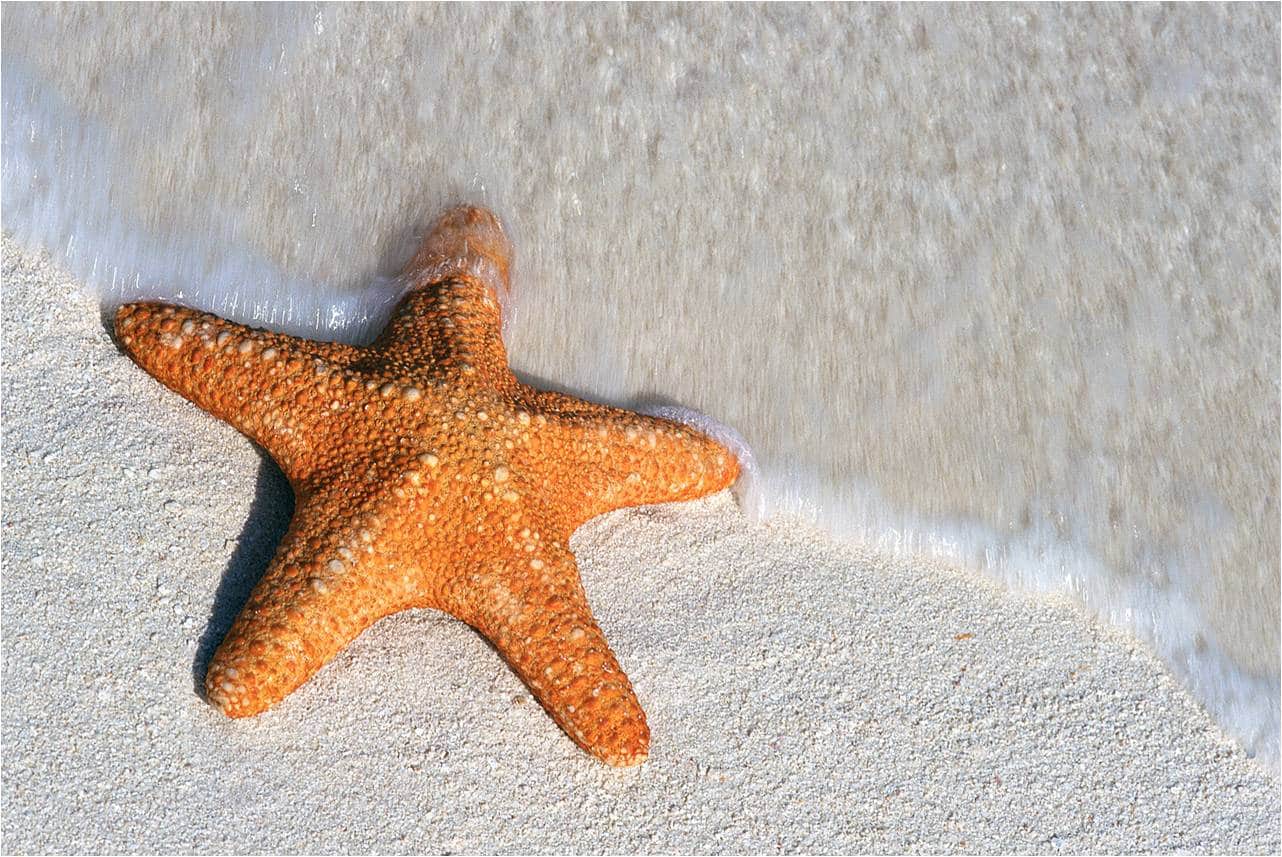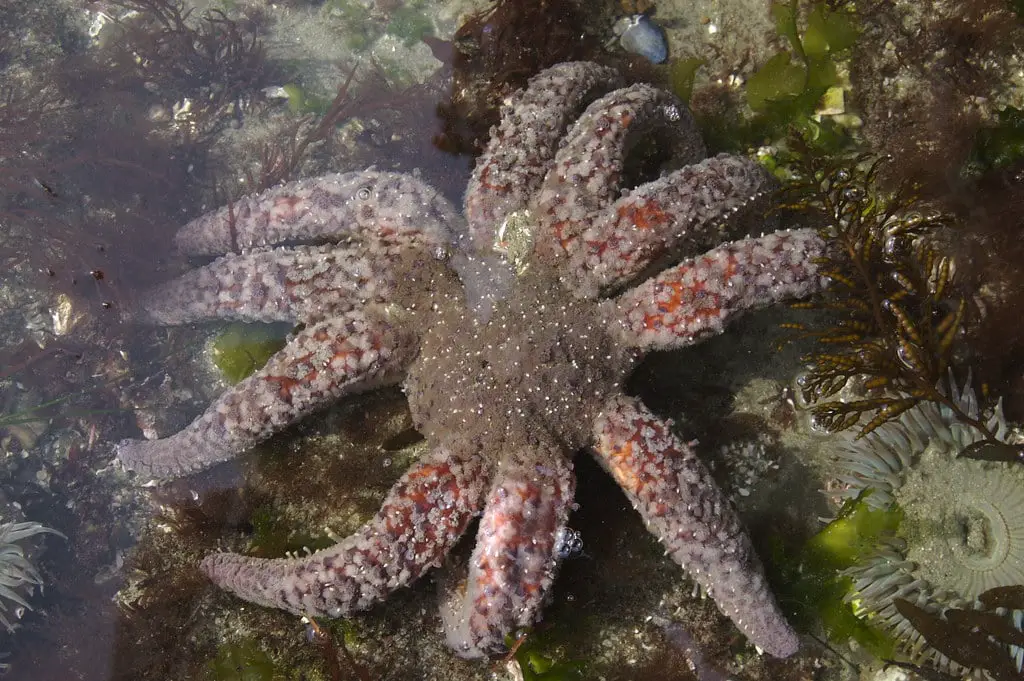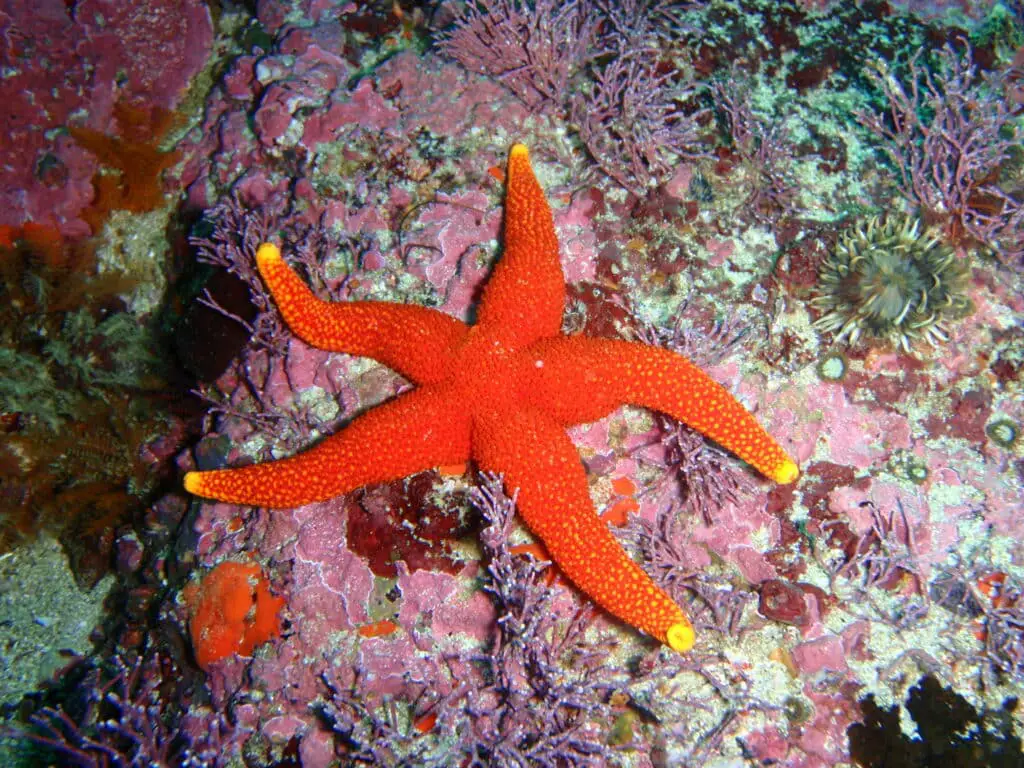Is A Starfish A Crustacean

Introduction
Is A Starfish A Crustacean: Whether a starfish is a crustacean often arises due to their similar appearances and shared habitat in the ocean. However, it is crucial to clarify that starfish and crustaceans are distinct groups within the animal kingdom, each with its unique characteristics and evolutionary history.
Starfish, scientifically known as echinoderms, belong to a group of marine animals known for their radial symmetry and spiny skin. They typically have five arms, although some species may have more, and they use a unique water vascular system to move and capture prey. Starfish are a diverse group, with over 2,000 species, and they play vital roles in marine ecosystems as both predators and scavengers.
On the other hand, crustaceans, such as crabs, lobsters, and shrimp, belong to the arthropod phylum, a category that also includes insects and spiders. Crustaceans are characterized by their jointed legs, hard exoskeletons, and two pairs of antennae. They have a wide range of body shapes and sizes and inhabit various aquatic environments, from the deep sea to freshwater streams.
While starfish and crustaceans may share some superficial similarities and live in the same aquatic realm, they are taxonomically distinct. Starfish belong to the echinoderm phylum, while crustaceans are part of the arthropod phylum. Understanding these differences helps us appreciate the incredible diversity of life in our oceans and the unique adaptations that have evolved in these fascinating creatures.
Is a starfish a fish or crustacean?
Sea stars used to be called “starfish,” but they’re not fish at all. They’re echinoderms, members of the same club as sea urchins, sea cucumbers, sea lilies and sand dollars.
A common misconception arises from the name “starfish,” which implies that it might be a type of fish. However, starfish are not fish at all. In fact, they belong to a completely different group of animals known as echinoderms. Echinoderms are marine invertebrates characterised by radial symmetry and a spiny skin. Starfish, also called sea stars, are part of this group.
On the other hand, crustaceans are a separate category within the animal kingdom. Crustaceans include animals like crabs, lobsters, shrimp, and crayfish. They are arthropods, characterised by their jointed legs, hard exoskeletons, and two pairs of antennae. Unlike starfish, crustaceans are not related to fish either, but they are closer relatives to insects and spiders within the arthropod phylum.
Neither starfish nor crustaceans are fish. Starfish are echinoderms, while crustaceans are arthropods. The confusion likely arises from the common names of these animals, which can be misleading. Understanding their proper classifications helps clarify their place in the animal kingdom and highlights the incredible diversity of life in the oceans.

What is a starfish classified as?
The class Asteroidea belongs to the phylum Echinodermata. As well as the starfish, the echinoderms include sea urchins, sand dollars, brittle and basket stars, sea cucumbers and crinoids.
Starfish, also known as sea stars, are classified as members of the phylum Echinodermata within the animal kingdom. This classification places them in a distinct and fascinating group of marine invertebrates. Echinoderms are characterized by several unique features:
Radial Symmetry: Starfish exhibit radial symmetry, meaning their bodies are organized around a central point, and they typically have five arms, although some species may have more.
Water Vascular System: One of the defining features of echinoderms, including starfish, is the presence of a water vascular system. This system consists of a network of fluid-filled canals and tube feet, which the starfish use for locomotion, capturing prey, and exchanging gases.
Spiny Skin: Echinoderms have a spiny or sometimes leathery skin that covers their bodies, offering protection and support.
Marine Habitat: Most echinoderms, including starfish, are exclusively marine animals, inhabiting oceans and seas around the world.
Unique Feeding Mechanism: Starfish are opportunistic feeders, and their diet includes a variety of prey, including mollusks and small marine organisms. They use their tube feet to pry open the shells of their prey and then evert their stomachs to digest their food externally before retracting it back into their bodies.
In the broader classification scheme, starfish belong to the class Asteroidea within the phylum Echinodermata. Understanding this classification helps scientists and researchers categorize and study these intriguing marine creatures and appreciate their essential roles in maintaining marine ecosystem balance.
Is a sea star a crustacean or echinoderm?
Echinoderms
Sea stars are related to sand dollars, sea urchins, and sea cucumbers, all of which are echinoderms, meaning that they have five-point radial symmetry. However, this does not mean that all sea stars have five arms and species with 10, 20, or even 40 arms exist!
A sea star is unequivocally an echinoderm, not a crustacean. Sea stars, also known as starfish, belong to the phylum Echinodermata, a diverse group of marine animals characterized by their spiny skin and radial symmetry. Echinoderms are evolutionarily distant from crustaceans, which fall under the phylum Arthropoda.
Echinoderms, like sea stars, are recognized for their five-point radial symmetry, a distinctive feature that sets them apart from crustaceans with their bilateral symmetry. Sea stars typically have a central disk from which radiate five or more arms, each lined with tube feet used for locomotion and feeding. Their endoskeleton is composed of calcareous plates, which gives them their unique texture.
In contrast, crustaceans, such as crabs, lobsters, and shrimp, belong to a completely different phylum. They exhibit bilateral symmetry and possess an exoskeleton made of chitin, a material distinct from the calcareous endoskeleton of echinoderms. Additionally, crustaceans are jointed-legged animals, another characteristic feature distinguishing them from sea stars.
When classifying a sea star, it is crucial to recognize it as an echinoderm, a distinct group within the animal kingdom, rather than confusing it with crustaceans, which belong to a separate and distant phylum.
Do starfish eat crustaceans?
Starfish species are voracious hunters, using their tube feet to capture and manipulate prey. These predators feed on a wide range of marine life, including shellfish such as clams, mussels and oysters, crustaceans like shrimp and crabs, worms, snails, sea cucumbers, and even sea urchins!
Starfish, also known as sea stars, are opportunistic feeders and do consume crustaceans as part of their diet. However, their diet is not limited to crustaceans alone, and they feed on a variety of prey items found in their marine habitats.
Starfish have a remarkable feeding mechanism that allows them to capture and consume different types of prey. They primarily use their tube feet to pry open the shells of mollusks, such as clams and oysters, which are a common part of their diet. Once the shell is opened, they evert their stomachs out of their mouths and into the shell, where they release digestive enzymes to break down the soft tissues of their prey. After digestion, they retract their stomachs and ingest the liquefied food.
Crustaceans, including small crabs and shrimp, can also fall prey to starfish. Starfish use their tube feet and sometimes their arms to capture and immobilize crustaceans, and then they begin the process of digesting them in a similar manner to mollusks.
It’s important to note that while starfish do consume crustaceans and other small marine creatures, their diet can vary depending on their species and the availability of prey in their environment. They are opportunistic feeders, and their feeding habits play a crucial role in maintaining the balance of marine ecosystems.
What is the real name for a starfish?
Classification and Scientific Name
The aquatic animal that is commonly known as a starfish is also frequently called a sea star. All of these animals fall into the class Asteroidea; in the scientific community, they are frequently known as asteroids.
The real name for what is commonly called a “starfish” is “sea star.” The term “starfish” has been widely used for these marine creatures due to their distinctive appearance, with typically five arms radiating from a central body, resembling a star. However, this name can be misleading, as sea stars are not actually fish; they are marine invertebrates.
In an effort to avoid confusion and promote accurate scientific terminology, marine biologists and scientists prefer to use the term “sea star.” This name reflects their true nature as echinoderms, a phylum of marine animals that includes sea stars, sea urchins, and sea cucumbers.
The use of “sea star” instead of “starfish” emphasizes their unique biological characteristics and evolutionary lineage. These fascinating creatures are known for their radial symmetry, spiny skin, water vascular system, and diverse range of species that inhabit oceans worldwide.
So, while “starfish” is a common and recognizable term, the scientifically accurate and preferred name is “sea star.” This distinction helps maintain clarity in the field of marine biology and highlights the diversity and importance of these remarkable marine invertebrates in our oceans.
How can I differentiate between a starfish and a crustacean?
You can differentiate them by looking at their physical characteristics. Starfish have a radial symmetry, typically with five arms, and a soft, spiny skin. Crustaceans have a bilateral symmetry, exoskeletons, and jointed legs. They also have distinct body shapes, with crustaceans having a more elongated appearance compared to the starfish.
Distinguishing between a starfish (sea star) and a crustacean is relatively straightforward when you know the key characteristics of each group:
Body Structure:
- Starfish: Starfish have a typically five-armed radial symmetry, although some species may have more arms. Their bodies are flat and star-shaped.
- Crustacean: Crustaceans have bilateral symmetry, meaning their bodies are divided into two similar halves. They typically have a hard exoskeleton, jointed legs, and appendages for locomotion.
Exoskeleton:
- Starfish: Starfish have a spiny or rough-textured skin covering their bodies, but they lack a hard exoskeleton like crustaceans.
- Crustacean: Crustaceans are known for their hard exoskeletons, which protect their bodies and provide structural support.
Legs and Appendages:
- Starfish: Starfish do not have jointed legs or appendages. They move using tiny tube feet located on the undersides of their arms.
- Crustacean: Crustaceans have jointed legs and often possess specialized appendages for activities like walking, swimming, and grabbing prey.
Antennae:
- Starfish: Starfish lack antennae.
- Crustacean: Crustaceans typically have two pairs of antennae, which they use for sensory perception.
Habitat:
- Starfish: Starfish are exclusively marine animals and are commonly found in oceanic environments.
- Crustacean: Crustaceans can inhabit both marine and freshwater environments. They are often found in oceans, lakes, rivers, and streams.
By observing these characteristics, you can differentiate between a starfish and a crustacean. Remember that while they may share the same marine habitat, they belong to different phyla within the animal kingdom—starfish are echinoderms, and crustaceans are arthropods. Understanding these distinctions will help you identify and appreciate the diversity of life in aquatic ecosystems.
What is the ecological role of starfish and crustaceans?
Both starfish and crustaceans play important roles in marine ecosystems. Starfish are predators, mainly feeding on bivalve mollusks, while crustaceans often serve as prey for larger marine animals. They help maintain the balance of marine populations and contribute to the overall health of the ocean ecosystem.
Starfish and crustaceans play distinct but equally vital ecological roles in marine ecosystems, contributing to the balance and health of these environments.
Ecological Role of Starfish (Sea Stars):
- Predator of Mollusks: Starfish are well-known predators of mollusks such as clams and oysters. They use their tube feet to pry open the shells of these organisms and then digest them externally, helping control mollusk populations.
- Scavengers: Starfish also feed on dead and decaying matter on the ocean floor. This scavenging behavior helps clean up the seafloor, preventing the buildup of organic debris.
- Keystone Species: In some ecosystems, particularly in intertidal zones, starfish serve as keystone species. Their presence can influence the abundance and distribution of other species by controlling the populations of prey species.
Ecological Role of Crustaceans:
- Detritivores: Many crustaceans, such as crabs and shrimp, are detritivores, feeding on decaying organic matter.
- Prey for Predators: Crustaceans are a significant food source for various marine predators, including fish, seabirds, and larger crustaceans.
- Bioturbation: Burrowing crustaceans, like ghost shrimp and burrowing crabs, engage in bioturbation, which involves digging and churning sediments.
- Indicator Species: Some crustaceans are used as indicator species in environmental assessments.
Can starfish and crustaceans coexist in the same habitat?
Starfish and crustaceans can coexist in the same habitat, and they often do in various marine ecosystems. While they belong to different phyla within the animal kingdom and have distinct ecological roles, many marine environments provide suitable conditions for both groups of organisms to thrive. Here are a few examples of habitats where starfish and crustaceans can coexist:
- Intertidal Zones: In intertidal areas where the ocean meets the shoreline, you can find both starfish and crustaceans. Starfish may feed on mollusks like clams, while crustaceans like crabs and shrimp occupy tidal pools and burrows in the same vicinity.
- Reef Ecosystems: Coral reefs and rocky reef environments are rich in biodiversity.
- Seagrass Beds: Seagrass beds are important nurseries for many marine species, including crustaceans.
- Kelp Forests: Kelp forests are highly productive ecosystems in which both starfish and crustaceans are commonly found. Starfish can navigate through the kelp blades, while crustaceans utilize the kelp as a substrate for shelter.
- Estuaries: Estuarine environments where freshwater meets the sea provide a diverse range of habitats. Starfish and crustaceans can coexist in tidal flats, mudflats, and salt marshes within estuaries.
While starfish and crustaceans can share these habitats, they may interact in various ways, including predation and competition for resources. Their coexistence highlights the complexity and richness of marine ecosystems, where multiple species interact and contribute to the overall ecological balance.

Conclusion
While both starfish and crustaceans share the marine environment and may appear similar at first glance, they belong to entirely different phyla in the animal kingdom.
Starfish, as echinoderms, exhibit radial symmetry, spiny skin, and a unique water vascular system. They have a distinct evolutionary history that sets them apart from crustaceans. Their role in marine ecosystems as predators and scavengers is vital for maintaining ecological balance.
Crustaceans, on the other hand, fall under the arthropod phylum, characterized by jointed legs, hard exoskeletons, and two pairs of antennae. This diverse group includes crabs, lobsters, and shrimp, each adapted to various aquatic habitats and ecological niches.
While it’s natural to draw parallels between these fascinating sea creatures due to their shared habitat and occasional physical resemblances, it is essential to recognize the fundamental differences in their biological classifications. Starfish and crustaceans belong to separate branches of the animal kingdom, showcasing the remarkable diversity and complexity of life on Earth.



